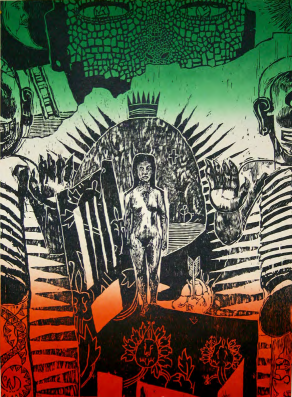
- 2006
- Color offset lithograph
- Image/sheet: 50.81 x 37.5"
- 8 prints in this edition
About the Print
From the Artist
The Virgin of Guadalupe is the equivalent of the Virgin Mary. She was an Aztec god and when the Spaniards took over the Aztec and converted them, they needed something to bind them together. So they took this goddess, the mother earth goddess Tonantzin. They actually put her in traditional Catholic garb and told the indigenous people that now she is your god, and little by little the people started accepting her. This piece has a lot of imagery that reveals what was happening there. The pattern on the chair is actually from her robe. Parts of the Mexican flag can be seen with the cactus and the snake. And above an Aztec mask is looking over.
I use chairs a lot in my work, to represent the church and the strength of the church. I remember always seeing a big chair in the middle of the aisle when you would walk down. I use this symbol to talk about authority. In this work Tonantzin is coming out and donning the robe and stepping into the role of authority, accepting the crown and becoming a new Catholic god to the Aztecs.
—From Brandywine Workshop and Archives recordsMy main inspiration is the border. I seek that the audience experiences that particular reality through art. Many of the images and icons from my own experience are unknown to the general public.
Another concept that I use often is the wall between Mexico and the States. The meaning of the border is something that I always grew up with, I had a childhood with aspects that delimited my experience.
The artistic experience is lived very differently in El Paso and Philadelphia. My works have been forged through the beauty and cultural richness of the border and also the very limitations of the region. But I wouldn’t trade my experience for nothing.
—From Brandywine Workshop and Archives records
About the Artist
Danny Alvarez is a Mexican-American mural painter and printmaker born in El Paso, TX. He received an MFA in printmaking from Tyler School of Art and Architecture at Temple University, Philadelphia. His art is in the collections of the Arizona State Museum, Tucson; University of Texas, Austin; and Philadelphia Museum of Art, among others.
—From Brandywine Workshop and Archives records
Curriculum Connections
Suggested Topics for Literature and Creative Writing
Creativity in response to Oppression
Marginalization, a form of oppression, assumes that an individual’s ability to perform a job is determined by their identity (Latin Americans are gardeners, African Americans are domestic servants, women are clerical assistants—while Native Americans are not seen as individuals, living human workers but as symbolic mascots for sports teams, etc.). In response to oppression, artists marshal their creative work as forms of resistance. Leaders like Martin Luther King advocated that the most potent forms of resistance were nonviolent. The arts are especially effective forms of nonviolent resistance as they give voice to the human spirit, emphasize our shared humanity, present startling juxtapositions by showing how oppression creates brutal realities for some and pleasure for others, and inscribe iconic aesthetic images that reverberate in our contemporary awareness and historical imaginations. Let’s explore how we feel about ourselves and our community role based on our passion, talents, background, and location.
Questions to Consider
- How do we define ourselves?
- In what ways do others define us?
